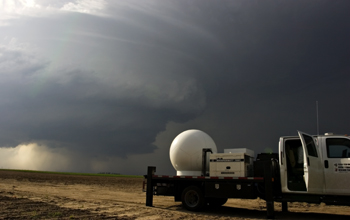Multimedia Gallery
Mobile Doppler Radar During VORTEX2
The TTUKa-1 mobile Doppler radar deployed in front of a supercell thunderstorm near Greensburg, Kan., on June 9, 2009. The TTUKa-1 was participating in the second Verification of the Origins of Rotation in Tornadoes Experiment (VORTEX2), funded by the National Science Foundation (NSF) (grant AGS 09-64088) and the National Oceanic and Atmospheric Administration. The project, which ran from 2009 to 2010, was the largest attempt in history to study the origin, structure and evolution of tornadoes and involved more than 50 scientists and 40 research vehicles, including 10 mobile radars.
More NSF coverage of VORTEX2 is available Here. The project's website can still be viewed Here, and you can read the daily blog that was established during the project's tenure, Here. Some great photos taken by VORTEX2 participant Jeff Frame of the University of Illinois at Urbana-Champaign can be viewed Here. (Date of Image: June 2009)
Credit: Patrick Skinner, Texas Tech University
See other images like this on your iPhone or iPad download NSF Science Zone on the Apple App Store.
Images and other media in the National Science Foundation Multimedia Gallery are available for use in print and electronic material by NSF employees, members of the media, university staff, teachers and the general public. All media in the gallery are intended for personal, educational and nonprofit/non-commercial use only.
Images credited to the National Science Foundation, a federal agency, are in the public domain. The images were created by employees of the United States Government as part of their official duties or prepared by contractors as "works for hire" for NSF. You may freely use NSF-credited images and, at your discretion, credit NSF with a "Courtesy: National Science Foundation" notation.
Additional information about general usage can be found in Conditions.
Also Available:
Download the high-resolution JPG version of the image. (2.5 MB)
Use your mouse to right-click (Mac users may need to Ctrl-click) the link above and choose the option that will save the file or target to your computer.



